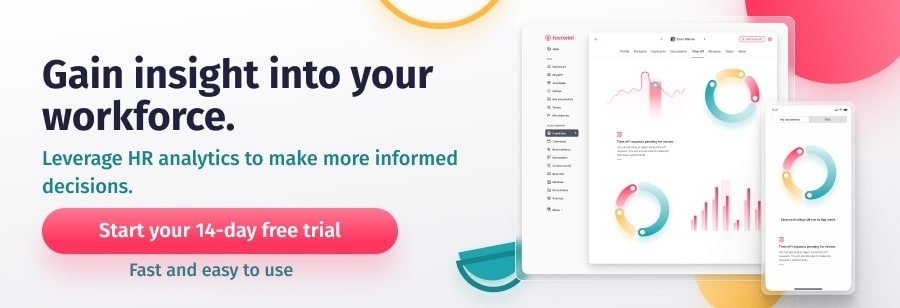One of the most common and essential metrics for HR is employee satisfaction or job satisfaction. Employee satisfaction is the level of contentment an employee feels. It determines their workplace experience as well as their attitude towards their company.
As part of our series on HR KPIs, we’re discussing how employee satisfaction determines the employees’ needs and motivations. Keeping track of employee satisfaction will help the company improve the employee experience and help employees grow.
Satisfaction breeds success. Thus, organizations need to know how to measure employee satisfaction.
- Why is it important to measure employee satisfaction?
- How to measure employee satisfaction
- The perfect methodology for measuring employee satisfaction
Why is Measuring Satisfaction of Employees Important?
Not tracking KPIs is very much like driving blindfolded. Although one might be familiar with the road towards a specific destination, with the inability to see, one cannot know when to make adjustments, especially when they start driving off course.
Correspondingly, without measuring and knowing how to measure the satisfaction level, it is almost impossible to keep away from adverse and negative trends. Further, it is difficult to stay on the right course. Either way, failure to gauge employee satisfaction can result in unhappy, dissatisfied employees who are not committed to their jobs, and at length, the company’s goals and mission.
Monitoring the satisfaction of employees, or its lack thereof, should be part of HR KPIs. Read on to find out why it is essential to know how to measure employee satisfaction.
It’s an Essential Piece of Overall Business Success
Companies that take the effort and time to motivate and engage their employees have a better chance at outperforming their competitors, thereby leading the industry.
Although there is yet a study indicating direct causation proving that job satisfaction results in higher productivity, studies suggest that there is still a correlation.
Using Gallup data, the London School of Economics and Political Science (LSE) conducted a study to touch on employee satisfaction and productivity. This study found a correlation between workplace satisfaction and enhanced company performance. Moreover, happy employees became more productive employees.
Furthermore, the study also suggests that employees showing high job satisfaction affect customer loyalty and profitability. This finding further proves that more than increasing productivity levels, workplace satisfaction can do more by bringing in more dedicated customers, thereby adding more to its bottom line.

Improves Employee Retention
Based on TINYpulse’s 2019 Employee Engagement Report, researchers found that employee retention is facing a crisis. More specifically, the report found that over 40% of employees are likely to leave their present company for a 10% pay raise. This finding is significantly higher from only 23% a few years back.
Gaining loyalty is no easy feat but is not at all a lost cause. Still, based on the report, the key differentiator to gaining employee loyalty is company culture. Quitting bosses or chasing a better, higher-paying opportunity is already a fact of life. However, a company’s culture is among the strongest factors that tell whether an employee will stay and stick around for the long run.
Employee satisfaction can help in righting the ship. However, its lack thereof can also cause that same ship to sink. In the same abovementioned report, experts found a negative correlation between satisfaction and turnover rates. Meaning, harboring a satisfied workforce is harboring a workforce that is less likely to leave.
Furthermore, research from Qualtrics suggests that managers assume a pivotal role in driving job satisfaction. Moreover, managers who help employees manage their workload and consistently acknowledge good performance were two out of three drivers for employee retention.
Ultimately, taking steps to be knowledgeable about measuring worker satisfaction can be crucial in improving employee retention.
Leads to Employee Engagement
Employee Satisfaction is not the same as Employee Engagement. However, a higher satisfaction level can naturally pave the path towards higher engagement levels.
Higher Employee Engagement fosters a stronger company culture, greater loyalty, and increased overall productivity. Furthermore, engaged employees not only focus on accomplishing their day-to-day tasks but also actively partake in achieving the company’s long-term goals. They do not just do their jobs. They bring ingenious ideas to the table.
Fostering an engaged workforce in an age where 40% of millennials and 60% of Gen Z employees are likely to leave a job within two years is important to stay ahead of the pact.
Gauging employee engagement can be done indirectly by conducting an employee satisfaction survey as well.
How to Measure Employee Satisfaction?
Employee satisfaction, as an HR KPI, encompasses several elements. Although a company may be good at one or two areas, falling short on other factors can still run the risk of housing a generally dissatisfied workforce. Among these factors are the following:
Working Conditions
At face value, one might come to accept the notion that a well-compensated employee is a satisfied employee. However, this does not always hold. As Don Rheem, CEO of E3 Solutions, put it, “Money… has minimal impact on daily behavior. Far more impactful are things that money can’t buy.”
Among these “impactful things” are workplace safety, both physically and emotionally, and a clean, healthy working environment. If employees do not look forward to coming to work every day, trust that their job satisfaction will be low along with other HR KPIs. If no measures, such as a workplace satisfaction survey, at least, are taken, do not be surprised if they soon leave.
Relationship with Supervisors
An employee’s relationship with supervisors is among the major indicators of an employee’s decision to stay or leave. Having a supervisor that does not care about their employees causes employees to quit a company. On the flip side of the coin, supervisors who foster a participative climate seem to have a more significant effect on employee satisfaction than participation in a specific decision.
Furthermore, employees tend to be satisfied when their supervisors recognize and praise them for their efforts and accomplishments and when their supervisors keep an open door for any concerns affecting their performance
Supervisors knowing how to build rapport with their employees is just as vital as learning how to measure satisfaction in general.

Employee Benefits
Good pay is necessary to keep employees satisfied. But, it should not end there. Taking care of employees must go beyond taking care of their wallets. Employees have other needs than money.
Aside from monetary compensation, it would be better for companies to check on their policies on paid time off, health and wellness perks, rewards, and incentives programs to ensure their employees’ satisfaction.
Job Description and Responsibilities
Finally, among the most critical factors that affect satisfaction is the fulfillment employees get from their job. In noting this factor, companies should consider answering the following questions:
- Is the job challenging and interesting?
- Does the job utilize their skills and education?
- Do people feel trusted and respected for their work?
- Do people see a clear upward path for continued growth and success?
No one wants to feel underutilized at work. A study reveals that feeling underutilized is the 5th reason why good employees voluntarily leave employment.
Methodology: Measuring Employee Satisfaction
There are formal and informal means of gauging workplace satisfaction. Companies may choose either of the two or integrate them to get a broader perspective of employee satisfaction.
Surveys
Surveys are among the most formal means of gauging satisfaction in the workplace. When conducting these surveys, it is best to ask short, open-ended questions requiring thoughtful responses. It is also essential to ensure the respondent’s anonymity to encourage candid, honest answers.
Although businesses can develop surveys in-house, there are organizations of experts that offer survey development services. For one, Factorial helps companies in creating and designing surveys. With its survey feature and reports and analytics feature, organizations not only produce satisfaction survey results but are also given strategic, actionable options for better decision making.
Informal Observation
With an informal but careful observation, company heads can already get hints on their employees’ satisfaction levels. With casual observation, company heads may ask the following questions:
- Do people miss work frequently?
- What is teamwork like in the office?
- How is the turnover rate?
Performance Review and Appraisal
Performance Review, or performance appraisal method, is an evaluation method gauging the employees’ performance for a specific period. These reviews are usually part of the individual career and organization’s internal record.
In the past, performance reviews were typically done semi-annually or annually. However, current research shows that more regular feedback can help employees to feel comfortable and grow more consistently. It is of the utmost importance that performance reviews are standardized and objectives. This is because they have may have implications for future pay raises and promotional structures for employees.
Accurate performance reviews have become even more important as more people work from home. With Factorial’s 360° performance review software, you can collect reviews from each reviewee’s manager, peers, and direct reports. This helps keep reviews objective and reduces unconscious bias.
Aside from telling how employees are doing, performance reviews are good opportunities for company heads to ask their people how they are doing and even how well their people think they are doing. Performance reviews allow employee-supervisor relationships to flourish while engendering trust and honesty, leading to subtly measuring employees’ job satisfaction.
With Factorial’s performance management feature,
Key HR KPIs: Employee Satisfaction
Although HR leaders can already feel their employees’ job satisfaction levels among other HR KPIs, data helps them prove or disprove these gut feelings with the power of analytics, thereby providing them actionable insights.
Integrating data from various sources, such as HR records, employee reviews, satisfaction surveys, actual production levels, and other HR KPIs, HR leaders can grasp each individual and what they can bring to the table.
Although exhaustive, especially without a big data technology such as analysis, using both types of measures can increase overall employee satisfaction, engagement, and loyalty. Thus, the value these processes provide far outweighs the long and difficult process the procedures entail.
If you want to tap into data without all the work, streamline your analytics with Factorial’s integrative data analytic software.








